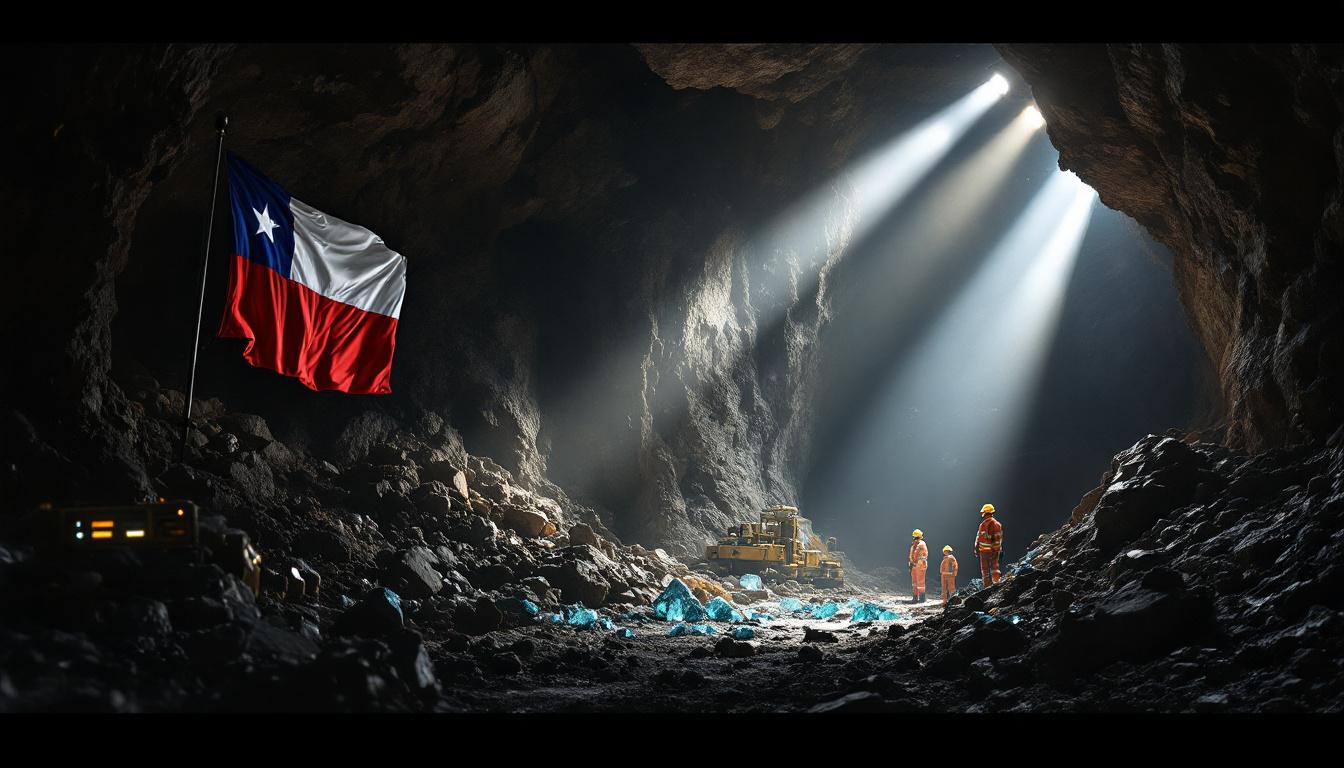El Teniente Mine Collapse: Understanding the Impact and Implications
The recent collapse at Chile's El Teniente copper mine has sent ripples through global copper markets and raised serious questions about mining safety protocols. This devastating incident represents one of the most significant mining disasters in Chile's recent history, with far-reaching consequences for both Codelco and international copper supply chains.
What Happened at Codelco's El Teniente Copper Mine?
Details of the Recent Collapse Incident
On July 29, 2025, a significant earthquake triggered a catastrophic underground collapse at Chile's El Teniente copper mine, one of the world's largest underground copper operations. The collapse resulted in six confirmed fatalities among mine workers, marking this as one of the deadliest mining incidents in Chile in recent years.
Search and rescue teams worked tirelessly in the days following the collapse, battling unstable ground conditions and the risk of secondary collapses. By August 4, 2025, rescue operations had concluded with the tragic confirmation of six deaths.
Safety Alert: Mining disasters like the El Teniente collapse highlight the inherent dangers of underground mining operations, particularly in seismically active regions like Chile's copper belt. Even with modern safety systems, natural disasters can overwhelm existing safeguards.
The incident occurred approximately 2,400 meters below the surface in one of the mine's primary production zones, where block caving operations were active. Initial reports suggest that despite early warning systems detecting unusual seismic activity, evacuation protocols were unable to clear all personnel from the affected area before the collapse occurred.
Current Status of Mining Operations
As of August 4, 2025, operations at Codelco's El Teniente mine remain suspended after collapse as investigators assess the extent of structural damage. Codelco has explicitly stated that operations will resume only when safety conditions permit, though the company has not yet provided estimates on production losses or financial impact.
According to Codelco's official statement: "We are committed to restoring operations as soon as safety conditions permit, but the effects of the stoppage cannot yet be estimated."
Surface processing facilities may continue limited operations using stockpiled material, but the suspension of underground extraction will inevitably create production bottlenecks in the coming weeks. The company's inability to provide timeline estimates suggests the damage may be extensive and complex to remediate.
Industry analysts note that each week of suspended operations at El Teniente represents approximately 8,000-10,000 tonnes of copper production loss, which could significantly impact Codelco's annual output targets if the suspension extends for multiple months.
How is Codelco Responding to the El Teniente Disaster?
Investigation and Safety Assessment Initiatives
Codelco is assembling an international panel of mining experts to conduct a comprehensive audit of the collapse and its causes. This panel will include specialists in geotechnical engineering, seismic monitoring, and underground mining safety from countries with advanced mining sectors, including Canada, Australia, and Sweden.
The investigation will focus on three critical areas:
- Seismic monitoring system effectiveness — Why early warning systems failed to prevent casualties
- Structural integrity assessments — Whether existing ground support was adequate for seismic conditions
- Emergency response protocols — Evaluation of evacuation procedures and refuge chamber accessibility
Technical assessment teams are currently evaluating the stability of remaining underground infrastructure, using remote sensing technology where direct access remains too dangerous. This includes drone-based LiDAR scanning and remote seismic monitoring to map the extent of damage to tunnels, shafts, and production areas.
Corporate Communications Strategy
The state-owned miner has maintained consistent communication through regulatory filings and press statements since the incident occurred. Codelco has emphasized its commitment to prioritizing worker safety over production targets, acknowledging the human cost of the disaster as its primary concern.
In its communications, Codelco has:
- Issued daily updates on rescue operations during the initial emergency phase
- Published a formal statement of condolence to the families of the deceased miners
- Committed to a transparent investigation process with findings to be made public
- Pledged support packages for affected families and trauma counseling for survivors
Company representatives have acknowledged they cannot yet estimate the full impact of the disaster on production or financial performance, focusing instead on the immediate human and safety concerns. This approach reflects a change in crisis management strategy following criticism of previous mining incident responses in Chile.
What is El Teniente's Significance to Global Copper Markets?
El Teniente's Production Profile
El Teniente stands as one of Chile's most significant copper operations and a cornerstone of Codelco's production portfolio. The mine typically produces approximately 450,000-500,000 tonnes of copper annually, representing roughly 20% of Codelco's total copper output and approximately 2.5% of global copper production.
El Teniente at a Glance:
| Category | Details |
|---|---|
| Type | Underground block caving operation |
| Annual Production | 450,000-500,000 tonnes copper |
| Operational Since | 1905 (over 120 years) |
| Current Depth | Up to 2,400 meters below surface |
| Reserve Life | Estimated 50+ years remaining |
| Workforce | Approximately 4,000 direct employees |
The mine's block caving operations represent some of the most technically advanced underground mining methods in the world, allowing for high-volume extraction at significant depths. Over its century-plus operational history, El Teniente has produced more than 31 million tonnes of fine copper.
What makes El Teniente particularly notable is its combination of scale, grade, and longevity. Few underground copper operations worldwide can match its production volume, and its reserves are expected to sustain operations well into the 2070s with ongoing development projects.
Market Implications of the Suspension
Copper prices rose up to 1.1% on the London Metal Exchange following news of the continued suspension at El Teniente, reflecting immediate market concerns about supply disruptions. The stoppage comes amid already constrained global copper supply conditions, with worldwide warehouse inventories at multi-year lows.
The timing of this disruption is particularly significant as it coincides with:
- Ongoing discussions about potential US tariffs on metals imports
- Reports of China considering limits on critical mineral exports
- Production challenges at several other major global copper operations
- Increasing demand forecasts driven by renewable energy and EV manufacturing
Market analysts are closely monitoring the situation for potential longer-term supply disruptions. Goldman Sachs commodities analysts noted in a recent report that "each month of full suspension at El Teniente could remove approximately 40,000 tonnes of copper from global supply, in a market already facing a projected deficit for 2025."
Market Insight: The El Teniente suspension highlights the vulnerability of copper supply chains to single-point disruptions. With electrification trends driving increased demand, such supply shocks may become more impactful on copper price predictions in coming years.
What Safety Challenges Do Underground Mines Like El Teniente Face?
Geological and Seismic Risk Factors
Underground block cave mining operations are inherently exposed to geotechnical risks, particularly in seismically active regions like Chile. El Teniente faces multiple natural hazard challenges:
- Tectonic activity — Chile's location along the "Ring of Fire" creates frequent seismic events
- Mining-induced seismicity — Block caving creates stress redistribution that can trigger localized seismic events
- Depth-related pressure — Operations at 2,400+ meters face enormous rock pressure
- Historical workings — Older sections of the century-old mine may have deteriorating ground support
Seismic activity in Chile presents ongoing challenges for deep mining operations. The country experiences approximately 2,000 measurable earthquakes annually, with dozens strong enough to potentially impact mining operations. Historical data shows a correlation between regional earthquake activity and mine stability incidents, though modern monitoring systems have generally improved predictive capabilities.
Rock mass behavior becomes increasingly unpredictable at greater depths. At El Teniente's current operational depths, rock bursts (explosive failures of overstressed rock) and unexpected ground movements become more common due to the immense pressure. These conditions require sophisticated ground support systems and constant monitoring.
Modern Safety Systems and Their Limitations
Contemporary mines employ extensive ground control monitoring technology, including:
- Microseismic sensor networks that detect rock movement in real-time
- Extensometers that measure tunnel deformation and convergence
- Fiber optic cables embedded in tunnel walls to detect strain changes
- Ground-penetrating radar to identify potential void spaces or weaknesses
Seismic detection systems at operations like El Teniente are designed to provide early warnings of potential instability. These typically include arrays of geophones and accelerometers connected to computerized monitoring systems that alert operators to unusual activity patterns.
Emergency response protocols include established evacuation procedures and refuge chambers—specially designed safe rooms equipped with air, water, and communications equipment where miners can shelter during emergencies. El Teniente has approximately 50 such chambers throughout its underground workings.
However, the El Teniente collapse highlights that even advanced safety systems have limitations. When major geological events occur suddenly, even the best warning systems may provide insufficient time for complete evacuation. Additionally, the sheer scale of modern mining industry evolution means that communicating emergency information to all personnel across vast underground workings remains challenging.
How Does This Incident Impact Codelco's Broader Operations?
Codelco's Operational Challenges
The state-owned miner faces increasing scrutiny over operational safety standards following this incident. Codelco operates several aging assets across Chile, many of which share similar geological and infrastructure challenges to El Teniente.
Codelco's operational portfolio faces multiple challenges:
- Aging infrastructure — Many operations have been active for 50+ years
- Declining ore grades — Copper content has fallen approximately 40% since 1990
- Increasing depths — Most operations now require deeper extraction
- Water constraints — Operations in Chile's arid regions face water scarcity
- Environmental compliance — Stricter regulations require significant investment
The company has been implementing a $40 billion modernization program across its operations, with approximately $3.4 billion specifically allocated to El Teniente's "New Mine Level" project designed to extend operations and improve safety. This incident may accelerate investment in safety infrastructure across all properties, potentially redirecting capital from production expansion to risk mitigation.
Financial Implications for the Chilean Copper Giant
Extended production stoppage will significantly impact Codelco's 2025 production targets. Prior to the incident, the company had projected total copper production of approximately 1.7 million tonnes across all operations, with El Teniente contributing roughly 25-30% of this total.
The financial implications extend beyond direct production losses:
- Insurance costs — Premiums will likely increase across all operations
- Regulatory penalties — Potential fines if investigations identify safety violations
- Capital reallocation — Safety improvements may divert funds from growth projects
- Investor confidence — Perceived operational risk may affect bond yields and financing costs
Codelco already faces financial pressures, with approximately $18 billion in debt and declining profitability due to lower ore grades and higher operating costs. In 2024, the company reported production costs of approximately $2.50 per pound, significantly higher than the $1.80 per pound average from a decade earlier.
Financial Note: For state-owned Codelco, production disruptions have implications beyond corporate finances. The company contributes approximately 10% of Chile's national budget through taxes and dividends, making operational challenges a matter of national economic concern.
What Does This Mean for Chile's Copper Industry?
Regulatory and Oversight Implications
Chilean mining authorities will likely conduct their own independent investigation parallel to Codelco's internal review. The country's National Geology and Mining Service (Sernageomin) has already dispatched investigators to the site and will play a central role in determining regulatory responses.
The incident may trigger industry-wide safety standard reviews and updates, potentially including:
- Revised seismic monitoring requirements for underground operations
- Enhanced emergency response protocols and evacuation system mandates
- More frequent and rigorous structural integrity assessments
- Stricter standards for ground support systems in high-risk areas
Regulatory oversight of underground mining operations could intensify significantly. Chile has historically maintained stringent mining regulations following previous disasters, most notably after the 2010 Copiapó mining accident, which resulted in substantial regulatory reforms.
New compliance requirements might emerge from governmental response, potentially creating additional operational constraints and costs for all Chilean copper producers, not just Codelco. Industry analysts suggest this could accelerate automation trends as companies seek to reduce human exposure to underground risks.
Impact on Chile's Copper Production Outlook
Chile remains the world's largest copper producer despite recent challenges, accounting for approximately 27% of global copper output. El Teniente's suspension temporarily reduces national production capacity by roughly 2-3%, depending on the duration of the stoppage.
The incident follows other operational challenges at Chilean copper operations, including:
- Water availability constraints in the northern mining regions
- Labor disputes at several major operations in 2024
- Declining ore grades across many mature mining districts
- Increased environmental compliance requirements
Long-term production forecasts may require adjustment depending on suspension duration and any resulting changes to operating practices. Chile's copper commission Cochilco had previously projected national production of 5.9 million tonnes for 2025, but this target now appears increasingly difficult to achieve.
How Might This Affect Global Copper Markets?
Supply Concerns in an Already Tight Market
Global copper inventories were already at historically low levels before this incident, with London Metal Exchange (LME) warehouses holding less than 180,000 tonnes—representing less than three days of global consumption. This limited buffer means supply disruptions have heightened sensitivity to production outages.
Market analysts are recalculating 2025 global copper supply outlook in light of the El Teniente situation:
- Previous consensus estimates projected a modest global deficit of 200,000-300,000 tonnes
- Extended disruption at El Teniente could potentially increase this deficit by 15-25%
- Replacement supply cannot be quickly mobilized due to long lead times for mine development
- Secondary (recycled) copper can only partially offset primary production losses
Price volatility may increase if the suspension extends beyond initial expectations. Copper had been trading in the range of $9,500-10,000 per tonne before the incident, and some analysts now suggest potential for prices to test $11,000 if the disruption extends beyond two months.
Intersection with Geopolitical Factors
The El Teniente situation coincides with reports of China considering limits on critical mineral exports as part of broader trade tensions. China accounts for approximately 50% of global copper consumption and any policy changes could significantly impact market dynamics.
US tariff discussions add another layer of complexity to copper market dynamics. The Biden administration has been considering potential tariffs on copper imports from certain countries, which could alter global trade flows and regional price differentials.
Supply security concerns are increasingly prominent in copper market analysis. Major economies including the US, EU, and Japan have identified copper as a strategic mineral essential for energy transition technologies, making supply disruptions a matter of economic security rather than just market dynamics.
The incident highlights vulnerability in global copper supply chains at a time when demand is projected to increase substantially due to:
- Electric vehicle manufacturing (each EV requires 2-4 times more copper than conventional vehicles)
- Renewable energy infrastructure (wind and solar installations are copper-intensive)
- Grid modernization projects worldwide
- Expansion of semiconductor and electronics manufacturing
Frequently Asked Questions
When will El Teniente resume operations?
Codelco has not provided a specific timeline for resuming operations. The company has stated that underground mining will restart only when safety conditions permit, following thorough investigations and implementation of necessary safety measures. Industry analysts estimate the process could take anywhere from 2-6 months depending on the extent of damage and required remediation.
What caused the collapse at El Teniente?
Initial reports indicate an earthquake triggered the collapse. However, Codelco is assembling an international expert panel to conduct a comprehensive investigation to determine the exact causes and contributing factors. The investigation will examine whether the earthquake was the sole cause or if other factors such as ground support adequacy or monitoring system failures played a role.
How does this incident compare to previous mining accidents in Chile?
While Chile has experienced several mining incidents historically, including the famous 2010 Copiapó mining accident where 33 miners were rescued after 69 days trapped underground, the El Teniente collapse represents one of the more serious recent incidents in terms of fatalities at a major operation. The Copiapó incident resulted in no fatalities but led to significant mining safety reforms, while this incident's death toll makes it the deadliest Chilean mining accident since 2010.
What safety improvements might result from this incident?
Potential improvements could include enhanced seismic monitoring systems, revised evacuation protocols, strengthened ground support standards, and more frequent safety audits. The findings from the expert panel will likely guide specific recommendations. Industry observers expect particular focus on early warning system improvements and refuge chamber placement optimization to ensure miners have adequate time and accessible safety options during sudden emergencies.
Industry Perspective: Mining safety experts note that each major incident typically drives significant technological advancement. The El Teniente collapse may accelerate development and adoption of autonomous mining technologies that reduce human exposure to high-risk underground environments.
The Path Forward for El Teniente and Codelco
The El Teniente mine collapse represents a critical juncture for both Codelco and Chile
Want to Know When the Next Major Mineral Discovery Happens?
Don't miss potentially lucrative investment opportunities in the mining sector. Stay ahead of the market with Discovery Alert's proprietary Discovery IQ model, delivering real-time notifications of significant ASX mineral discoveries straight to your inbox. Visit our discoveries page to see how historic mineral discoveries have generated exceptional returns for early investors.




